Physico-Chemical Analysis of Ground Water in Municipal Area of Bijapur (Karnataka)
S. C. Hiremath1 , M. S. Yadawe2 , U. S. Pujeri2 , D. M. Hiremath2 and A. S. Pujar2
1
Com. B.H.S.Arts and T.G.P. Science College,
Jamkhandi
India
2
S.B.Arts and K.C.P.Science College,
Bijapur
India
DOI: http://dx.doi.org/10.12944/CWE.6.2.09
Analysis physico-chemical parameters of ground water of municipal area of Bijapur (Karnataka) was carried out seasonally to study the quality of water and suitability for domestic purpose. Talabs (Lakes), Baudy (Wells constructed by Adil Shahi Sultans in 16th &17th century ) and bore wells are water resources of the study area. Thirty six samples from different sources at different locations were collected in different seasons during Year 2010-11. The parameters: pH, EC, TDS, Turbidity, Total hardness and content of Fluoride, Sulphate, Chloride were studied and compared with the standard values prescribed by ICMR, WHO and APHA. The present investigation revealed that the quality of water of a source varies from season to season and some of the water samples are unfit for drinking and utility purpose.
Copy the following to cite this article:
Hiremath SC, Yadawe MS, Pujeri US, Hiremath DM, Pujar AS. Physico-Chemical Analysis of Ground Water in Municipal Area of Bijapur (Karnataka). Curr World Environ 2011:6;265-269 DOI:http://dx.doi.org/10.12944/CWE.6.2.09
Copy the following to cite this URL:
Hiremath SC, Yadawe MS, Pujeri US, Hiremath DM, Pujar AS. Physico-Chemical Analysis of Ground Water in Municipal Area of Bijapur (Karnataka). Curr World Environ [serial online] 2011;6:265-269. Available from: http://www.cwejournal.org/?p=1382
Download article (pdf) Citation Manager Publish History
Select type of program for download
| Endnote EndNote format (Mac & Win) | |
| Reference Manager Ris format (Win only) | |
| Procite Ris format (Win only) | |
| Medlars Format | |
| RefWorks Format RefWorks format (Mac & Win) | |
| BibTex Format BibTex format (Mac & Win) |
Article Publishing History
| Received: | 2011-08-20 |
|---|---|
| Accepted: | 2011-10-02 |
Introduction
Water is considered absolutely essential to sustain life. In India ground water has a major role to satisfy the needs of domestic and agriculture purposes. The ever growing demands for water resources coupled with the rate at which much of the earths fresh water being adversely affected by human activities, demonstrate a developing crisis and horrible future if environmental water resources are not appropriately managed.1 Bijapur is not an exception to this future crisis. Indeed, Bijapur with an average annual rain fall of 553 mm is a city located in an area that suffers critically from a shortage of water resources. So the conservation of improvised water resources is indispensable for the sustainability of our economic development. For this reason, in the past few decades more attention has been given to the water quality of Bijapur. Bijapur is facing water quality problems as well as drinking water shortage, specially during summer season. Many people from the city are suffering from health problems due to consumption of the available contaminated water.
There are many Talabs (lakes) and Bowdies (wells) constructed by Adil Shahi Sultans in 16th and 17th century were the drinking water resources for about 15 lakh population of the imperial city in those days. According the report of Sykes British surveyor there were 700 well in the Bijapur city. Out of them some are still living but not maintained. Some of them have become dumping places for garbage. Taj Bowdy and Chanda Bowdy, the beautifully constructed wells witness the glory of the empire and architecture of the age.
Now the municipal corporation of Bijapur supplying the Krishna River water through pipe line from Alamatti reservoir which is about 45km from Bijapur. But it is also not sufficient for the need and hence the people of the city facing the severe water crises particularly in summer.
The effective maintenance of water quality of local resources through appropriate control measures, continuous monitoring of their quality parameters and their use as a supplement to river water may reduce the water crisis of the city. Also the information on water quality of Bijapur is scanty. Hence, the present work, seasonally determining suitability of ground water for drinking and other purposes of Bijapur city area is taken up. The present study also strengthens the national and local water quality data base.
Materials and Methods
Ground water samples were collected for physico-chemical analysis from 12 sites during summer (May 2010 ), rainy ( Sepember-2010) and winter (January-2011) seasons. Ground water, samples were collected in sterilized plastic containers (PVC 1000ml) after flushing out the tube wells (minimum 10 minutes) to get the fresh ground water and grab sampling method was followed in case wells. The containers were sealed and the samples were protected from direct sunlight during transportation. The water pH was determined by Systronics Digital pH meter standardized with buffer tablets. Electrical conductivity(E.C.) was determined using Elico digital conductometer standardized with KCl solution. Total Dissolved Solids(TDS) was determined by using digital TDS meter standardized with NaCl. Turbidity(TUR) of the samples were determined by using Systronics Nephelo Turbidity Meter-120 standardized with the mixture of solutions of Hydrazine sulphate and hexamethylene tetramine. Fluoride(F-), Chloride (Cl-), Sulphate (SO4- -) were estimated with standard methods as prescribed by Goltman et al2 (1978), Trivedi and Geol (1984)3 and APHA (1998).4
Results and Discussion
The seasonal variations of physico-chemical characteristics are given in the Table-1-3 for the winter, summer and rainy seasons. Climatic factors such as rainfall, temperature, pressure and humidity etc play an important role in the geology as well as terrestrial environment. A sound knowledge of these factors help in understanding the complex processes of interaction between the climate and biological processes in water bodies.
pH is the scale of intensity of acidity and alkalinity of water and measures the concentration of hydrogen ions. In the present study, the values the pH were in the range 7.0-8.2. The least value was recorded to be 7.0 in the month of January for sample S9, while maximum was recorded to be 8.2 in May for sample S6. Most of the biological processes and biochemical reactions are pH dependant. pH is considered as an indicator of overall productivity that causes habitat diversity.5 pH was found to be alkaline in nature at all the sites.6 The pH was observed to decline during winter and increases during the summer as is evident from the mean values.7 The lower value of pH during rainy season compared to summer, may be due to dilution of alkaline substance.
Physico-Chemical Parameters of water sources of municipal area of Bijapur
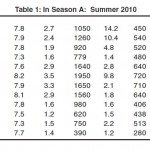 |
Table 1: In Season A: Summer 2010 Click here to View table |
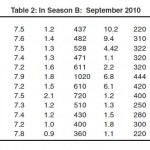 |
Table 2: In Season B: September 2010 Click here to View table |
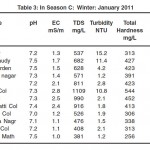 |
Table 3: In Season C: Winter: January 2011 Click here to View table |
The electrical conductivity was recorded highest in summer for sample S6 3.5mS/m and lowest in winter and rainy season 0.9mS/m for sample S12. There are no prescribed standards suggested by WHO for parameters electrical conductivity for drinking purpose. So no comparison can be made from observed values. The sample 4,9 and 10 show less seasonal variation of conductance where as samples 1,2,6 and 7 show large seasonal variation.
Total dissolved salt was in the range of 360- 1020mg/L in rainy season and 390-1950mg/L summer. TDS is the term used to describe the inorganic salts and small amount of organic matter present in solution of water. TDS values of water samples are within the highest desirable or maximum permissible limit set by WHO8 except sample no. 5,6,7 and 8 in summer where as for sample 12 within desirable limit in all the season.
The turbidity was within permissible limit except sample no. 1, 2 and 6. The variations in trend of turbidity and total solids is approximately is similar in different seasons and the average these parameters is higher in summer compared to rainy and winter season. It is evident that the discharge variations are commensurate with weather conditions and seasons variations.
Total hardness is the indicator of hydrogeology and aesthetic quality of water. The hardness was ranged from 720mg/L (maximum in summer) to 220mg/L ( minimum in winter). These findings suggests that the water body is moderately hard and high medium productive during present stage. Similar findings were also observed by Sehgal15 and Das16 in their studies. Water total hardness is imparted mainly by the calcium and magnesium ions, which apart from sulphate, chloride and nitrates are found in combination with carbonates
Fluoride concentration of water sample was minimum for winter (0.8 mg/L) and maximum for summer season(1.6mg/L), which are within the permissible limit of WHO. High fluoride concentration causes dental fluorosis 9,10, while low concentration causes dental caries. Hence it is essential to maintain moderated concentration of fluoride in drinking water.
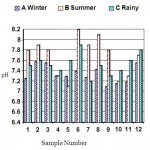 |
Figure 1: Click here to View figure |
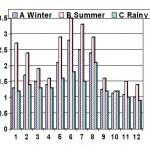 |
Figure 2: Click here to View figure |
Chloride is the indicator of contamination with animal and human waste. Chloride is a common constituent of all natural water and is generally not classified as harmful constituent.11 The chloride contents varied from 490mg/L (in summer in sample S8) to 105mg/litre (in rainy season in sample S12), which indicates pollution status of water body. Concentration of sulphate ion was minimum in rainy and winter season in sample- 12 (120mg/litre) and maximum (650mg/litre) in summer. Sulphate concentration is within the desirable limit of WHO in sample 10 and 12 in all the season while in sample 6 and 7 higher than the maximum permissible limit in the seasons. Concentration of sulphate has laxative effect12 which is enhanced when sulphate is consumed with magnesium. Water containing magnesium sulphate (1000mg/litre) acts as purgative in human adults.
Conclusion
Analysis of Bijapur water resources in three seasons rainy, winter and summer during 2010-11, shows that Sample No 4,10 and 12 are suitable for drinking in all the seasons while Sample No 1,2,5,6 and 7 are not suitable for drinking in all the seasons. The effective maintenance of water quality of local resources through appropriate control measures, continuous monitoring of their quality parameters and their use as a supplement to river water will reduce the water crisis of the city.
Acknowledgement
The authors are thankful to the B.L.D.E. Association’s SB.Arts and KCP Science College Bijapur, Com.BHS Arts and TGP Science College Jamkhandi for providing the facility and UGC for financial support.
References
1. Peterson N., Bricheer O., Kennedy M.; Water quality trends and geological mass balance; John Whiley and Sons, p-139-179, (1997)
2. Goltman H.Z., Clymo R.S. and Ohnstad M.A.M.; Methods for physical and chemical analysis of fresh water, I.B.P.H. and Book No.8, 2nd edition Black well Scientific, Oxford (1978)
3. Trivedi R.K. and Goel P.K.; Chemical and Biological methods for water pollution studies, Environmental Publication, Karad, India(1984)
4. APHA Standard Methods for Chemical Examination of water and waste water, American Public Health Association 20th edn , Washington D.C. (1998)
5. Minns C.K.; Factors affecting fish species richness in Onleria lake, Transaction of American Fish Society, 118,533-454, (1989)
6. Praparna N and Shashikant K.; Pollution level in Hussain sagar lake of Hyderabad. A case study. Pollution Research 21; 187-190, (2002)
7. Hulchinson G.E.; A Treatise on Limnology, Vol.I Part-2, Chemistry of lakes, John Whiley and Sons, Newyark (1957)
8. Trivedi R.K. and Goel P.K. ; Chemical and Biological methods for water and soil pollution studies, Environmental publication, India (1986)
9. Meenakshi, Garg V.K., Kavita R and Mallik A; Ground water quality in some villages of Haryana, India., Focus on fluoride and fluorosis, J. Han Mater. 106, 85-97, (2004)
10. Yadawe M.S., Hiremath D.M. and Patil S.A.; Assessment of Fluoride content in Ground and Surface water and its environmental impacts at Basavan Bagewade and Muddebihal Taluka of Bijapur District.; EJournal of Chemistry , Vol-7, Part-II (2010)
11. Jayanta Chutia and Siba Prasad Sarma; Relative content of chloride and sulphate in drinking water samples in different localities of Dhakuakhana Sub division of lakhimpur District of Assam; International Journal of Chemical Sciences; 7(3) 2009, 2087-2095
12. Lorraine C.B.; Assessing the acute gastro intestinal effects of ingesting naturally occurring high levels of sulphate in drinking water. Crit. Rev. Clin. Lab. Sci, 37,389-400, (2000)







